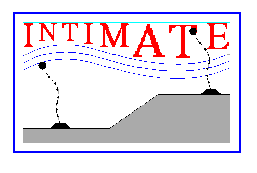|
You are not Logged in! Log in to check your messages. |

|
|
Check todays hot topics |
Web2Project Sign in
Project INTIMATE

INternal TIde Measurements with Acoustic Tomography Experiments (INTIMATE)
INTIMATE (PRAXIS XXI contract 2/2.1/MAR/1698/95) Today acoustics is one of the main tools for ocean exploration. Inspired by a technique from biomedical engineering, Ocean Acoustical Tomography (OAT) consists of the use of one or more acoustic sensors/sources strategically distributed in a volume of water and simultaneously emitting and receiving coded signals. The ``comparison'' of the emitted and received signals allows for the acoustical characterization of the environment in between the source(s) and the receiver(s). The experiments that have been performed to date, mainly in deep water, showed that it is possible to estimate: (1) the temperature over the water column, (2) the physical characteristics of the sea bottom and (3) the velocity and direction of currents. This project is financed by the PRAXIS XXI program, with 225 keuros for 3 years. Starting date: January 1st, 1997. Coordinator: S.M. Jesus (CINTAL). Participants: E. Coelho (Instituto Hidrográfico, Lisbon), Y. Stephan (CMO-SHOM) and M. Porter (NJIT).
Abstract:
Today acoustics is one of the main tools for ocean exploration. Inspired by a technique from biomedical engineering, Ocean Acoustical Tomography (OAT) consists of the use of one or more acoustic sensors/sources strategically distributed in a volume of water and simultaneously emitting and receiving coded signals. The ``comparison'' of the emitted and received signals allows for the acoustical characterization of the environment in between the source(s) and the receiver(s). The experiments that have been performed to date, mainly in deep water, showed that it is possible to estimate: (1) the temperature over the water column, (2) the physical characteristics of the sea bottom and (3) the velocity and direction of currents.
Due to the large water mass involved and its periodic nature, internal tides signatures have been frequently observed during ocean tomography experiments in the Bay of Biscay. In the continental shelf, internal tides are extremely important to the study of the coastal dynamics with a very special relevance close to the shelf break and to topographic irregularities like submarine canyons. This project aims at proving the concept of using vertical arrays of sensors and acoustic sources in the band 50 - 400 Hz for tomographic estimation of the oceanographic characteristics of internal tides on the continental shelf up to 200 m depth. During the project, areas of interest near the coast will be selected for at sea testing including the validation of the tomographic results with ground truth measurements. The conclusions of this study are hoped to bring a better knowledge of the internal tide phenomena and its impact on the coast dynamics. This should lead to improved prediction accuracy for coastal dynamical models and to a better management of existing resources. The results will also be important in providing more refined predictions of the impact of potential ecological accidents and climate changes.
Objectives:
 to conduct a theoretical/parametric
study for determining the performance of a source-receiver system for the inversion of
oceanographic parameters in shallow water. Determine the characteristics of the system
(frequency, resolution, array aperture, depth, etc.,...) for an optimal performance on
typical scenarios off the portuguese/french coast using oceanographic archival data.
to conduct a theoretical/parametric
study for determining the performance of a source-receiver system for the inversion of
oceanographic parameters in shallow water. Determine the characteristics of the system
(frequency, resolution, array aperture, depth, etc.,...) for an optimal performance on
typical scenarios off the portuguese/french coast using oceanographic archival data. to establish the capabilities of the
tomographic system to study internal tides on the continental shelf. Test of
theoretical-parametric models and estimation of their characteristic parameters.
to establish the capabilities of the
tomographic system to study internal tides on the continental shelf. Test of
theoretical-parametric models and estimation of their characteristic parameters. to test the complete system in
preselected coastal areas and validate it with ground truth data.
to test the complete system in
preselected coastal areas and validate it with ground truth data. to draw conclusions on the limitations
of the theoretical and operational methods that were developed. Make recommendations for
future developments of OAT systems in shallow water and their use for studying internal
tides.
to draw conclusions on the limitations
of the theoretical and operational methods that were developed. Make recommendations for
future developments of OAT systems in shallow water and their use for studying internal
tides.
